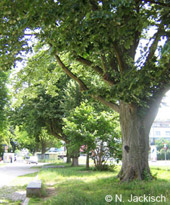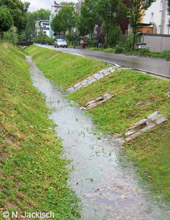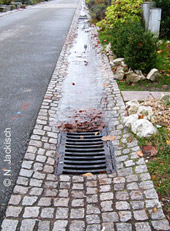
Biocides are classified according to the European Biocide Regulation No. 528/2012 and differ from plant protection products by definition only by the "intention of use". While plant protection products are intended to control unwanted pests in agriculture in order to improve yields, biocides are used to protect materials. Biocides and pesticides are grouped under the term pesticides and can be the same substances on a chemical basis.
Biocides are used to protect building materials, both outdoors and indoors, or are used "to protect" humans, such as in bug spray or disinfectants. According to the German Federal Environment Agency, there were approximately 43,000 biocidal products on the market at the beginning of 2017 (Umweltbundesamt, 2017).
One common application of biocides is in facade paints. Here they serve to prevent algae and fungal growth. As a rule, the organisms do not harm the building fabric, but are perceived as aesthetically unsightly.
Biocides are used to protect building materials, both outdoors and indoors, or are used "to protect" humans, such as in bug spray or disinfectants. According to the German Federal Environment Agency, there were approximately 43,000 biocidal products on the market at the beginning of 2017 (Umweltbundesamt, 2017).
One common application of biocides is in facade paints. Here they serve to prevent algae and fungal growth. As a rule, the organisms do not harm the building fabric, but are perceived as aesthetically unsightly.

In order for biocides to exert their effects, they must come into direct contact with potential harmful organisms. To ensure lasting protection, biocides must be permanently available on the surface of house facades. When rainwater hits the house façade, the biocides are released from the protective coating in which they were bound and transported with the water to the surface of the façade. There they can be washed off and enter the environment. Scientific studies show on the basis of measurements that biocides find their way into sewage treatment plants through leaching. According to the German Federal Environment Agency, biocide residues have even been found in earthworms on fields that were fertilised with biocide-contaminated sewage sludge. Biocide residues have also been detected in fish living in waters into which sewage treatment plants drain.

Biocides can enter groundwater and surface water in many ways. Some exemplary paths are listed below:
- First of all, all biocides that do not adhere directly to the materials can enter the environment. Possibilities are volatilization or washing away by precipitation water.
- Leached biocides may enter soils, surface waters or groundwater.
- Entries into the sewer system are fed into the wastewater treatment plant in the case of combined sewer systems. In the case of separate sewer systems, the stormwater (also with possible biocide contamination) is fed directly to the receiving waters. According to the German Federal Environment Agency, this applies to about 40% of the sewer systems in Germany.
- For combined sewer systems, all biocides that are not retained by biological and chemical degradation processes or by sorption (especially in sediments or sewage sludge) are discharged to receiving waters via the treatment plant effluent.
- Nowadays, decentralised stormwater infiltration is increasingly being considered as a solution for the infiltration of stormwater. However, biocides can also be introduced with the stormwater. Fast paths into the groundwater are particularly problematic, as they can occur in soils with preferential flow paths, e.g. earthworm passages or old root tubes.
- If sewage sludge is used as fertiliser, biocides contained in it can be dissolved and also released into the environment.
Literature:
- • Umweltbundesamt (2017): Sind Biozideinträge in die Umwelt von besorgniserregendem Ausmaß? Empfehlungen des Umweltbundesamtes für eine Vorgehensweise zur Untersuchung der Umweltbelastung durch Biozide. Hg. v. Fachgebiet IV 1.2 Biozide, Umweltbundesamt. Umweltbundesamt. Dessau-Roßlau. (“Are biocide inputs to the environment of concern? Recommendations of the Federal Environment Agency for a procedure to investigate environmental pollution by biocides”)





